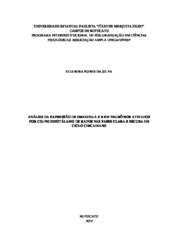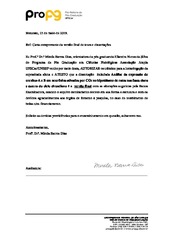| dc.contributor.author | Silva, Eliandra Nunes da | |
| dc.date.accessioned | 2019-09-19T17:07:56Z | |
| dc.date.available | 2019-09-19T17:07:56Z | |
| dc.date.issued | 2019-03-15 | |
| dc.identifier.citation | SILVA, Eliandra Nunes da. Análise da expressão de orexina-A e B em neurônios ativados por CO2 no hipotálamo de ratos nas fases clara e escura do ciclo circadiano. 2019. Dissertação (Mestrado em Ciências Fisiológicas) – Universidade Federal de São Carlos, São Carlos, 2019. Disponível em: https://repositorio.ufscar.br/handle/ufscar/11865. | * |
| dc.identifier.uri | https://repositorio.ufscar.br/handle/ufscar/11865 | |
| dc.description.abstract | Orexinergic neurons (OX) located in the lateral hypothalamus (LH), lateral and medial perifornical area (LPeF/MPeF) and dorsomedial hypothalamus, through orexin-A or orexin-B, can exert influence on hypercapnic ventilatory responses, acting directly in respiratory control areas or modulating the activity of other chemossensitive sites. Despite the evidence about the role of orexinergic system in central chemoreflex, the differences in the activation of these neurons by CO2 in the light and dark phase of the circadian cycle, as well as the likely differential activation between the hypothalamic nuclei that contain these neurons, is poorly understood. In the present study, in Wistar rats submitted to normocapnic or hypercapnic conditions (7% CO2), immunohistochemical protocols evaluated the number of Fos, orexin-A, orexin-B and neurons that co-localize Fos with Orexin-A or B in the LH, LPeF, MPeF e DMH in the light and dark phase of the diurnal cycle. Quantitative analysis of the expression of immunoreactive neurons showed that hypercapnia causes an increase in the number of neurons expressing Fos protein in LH, LPeF, MPeF and DMH in the light and in the dark phase of the diurnal cycle. In addition, there was an increase of orexin-A in hypercapnia in the light phase in LH, while there was decrease of orexin-A in hypercapnia in the dark phase in LPeF, MPeF and DMH. Neurons that co-localize Fos and orexins augmented in both phases of the diurnal cycle in the LH, LPeF and DMH, whereas in the MPeF this increase was observed only in the light phase. These results attest to the chemosensitive function of the hypothalamic region comprising LH, LPeF, MPeF and DMH and suggest that the role of these areas in the central chemoreflex involves the orexinergic neurons, independently of the phase of the light-dark cycle, with the exception of the MPeF, that seems to have a subpopulation of orexinergic neurons that act especially in the light phase. | eng |
| dc.description.sponsorship | Coordenação de Aperfeiçoamento de Pessoal de Nível Superior (CAPES) | por |
| dc.description.sponsorship | Fundação de Amparo à Pesquisa do Estado de São Paulo (FAPESP) | por |
| dc.language.iso | por | por |
| dc.publisher | Universidade Federal de São Carlos | por |
| dc.rights | Attribution-NonCommercial-NoDerivs 3.0 Brazil | * |
| dc.rights | Attribution-NonCommercial-NoDerivs 3.0 Brazil | * |
| dc.rights.uri | http://creativecommons.org/licenses/by-nc-nd/3.0/br/ | por |
| dc.subject | Quimiorrecepção central | por |
| dc.subject | Hipercapnia | por |
| dc.subject | Hipotálamo | por |
| dc.subject | Ciclo circadiano | por |
| dc.subject | Imunohistoquímica | por |
| dc.subject | Central chemoreception | eng |
| dc.subject | Hypercapnia | eng |
| dc.subject | Hypothalamus | eng |
| dc.subject | Circadian cycle | eng |
| dc.subject | Immunohistochemistry | eng |
| dc.title | Análise da expressão de orexina-A e B em neurônios ativados por CO2 no hipotálamo de ratos nas fases clara e escura do ciclo circadiano | por |
| dc.title.alternative | Analysis of orexin-A and B expression in CO2-activated neurons in the hypothalamus of rats in the dark and light phases of the circadian cycle. | eng |
| dc.type | Dissertação | por |
| dc.contributor.advisor1 | Dias, Mirela Barros | |
| dc.contributor.advisor1Lattes | http://lattes.cnpq.br/3203493045928389 | por |
| dc.contributor.advisor-co1 | Horta Júnior, José de Anchieta de Castro e | |
| dc.contributor.advisor-co1Lattes | http://lattes.cnpq.br/2577584360099382 | por |
| dc.description.resumo | Os neurônios orexinérgicos (OX) localizados no hipotálamo lateral (LH), área perifornicial lateral e medial (LPeF/MPeF) e hipotálamo dorsomedial (DMH), por meio da liberação de orexina A ou orexina B, podem influenciar a resposta ventilatória hipercápnica agindo diretamente em áreas de controle respiratório ou modulando a atividade de sítios quimiossensíveis. Apesar das evidências sobre o papel do sistema orexinérgico na quimiossensibilidade central, pouco se sabe a respeito das diferenças na ativação desses neurônios pelo CO2 entre as fases clara e escura do ciclo circadiano, bem como sobre a possível ativação diferencial entre os núcleos que expressam esses neurônios. Neste trabalho, através de protocolos imunohistoquímicos, avaliamos, em ratos Wistar submetidos à condições normocápnicas ou hipercápnicas (CO2 a 7%), o número de neurônios imunorreativos à Fos, orexina-A, orexina-B e de neurônios que co-localizam Fos com Orexina-A ou B no LH/PFA/DMH nas fases clara e escura do ciclo diurno. A análise quantitativa da expressão de neurônios imunorreativos mostrou que a hipercapnia provoca um aumento do número de neurônios que expressam a proteína Fos no LH, LPeF, MPeF e DMH, na fase clara e na fase escura do ciclo diurno. Além disso, houve aumento de orexina-A em hipercapnia na fase clara no LH, enquanto ocorreu diminuição de orexina-A em hipercapnia na fase escura na LPeF, MPeF e DMH. Neurônios que co-localizam Fos e orexinas aumentaram em ambas as fases do ciclo diurno no LH, LPeF e DMH, enquanto que na MPeF esse aumento foi observado somente na fase clara. Tais resultados atestam a função quimiossensível da região hipotalâmica que compreende o LH, LPeF, MPeF e DMH e sugerem que o papel dessas áreas no quimiorreflexo central envolve os neurônios orexinérgicos, de forma independente da fase do ciclo claro-escuro, com exceção da MPeF que parece ter uma subpopulação de neurônios orexinérgicos que atuam especialmente na fase clara. | por |
| dc.publisher.initials | UFSCar | por |
| dc.publisher.program | Programa Interinstitucional de Pós-Graduação em Ciências Fisiológicas - PIPGCF | por |
| dc.subject.cnpq | CIENCIAS BIOLOGICAS::FISIOLOGIA | por |
| dc.subject.cnpq | CIENCIAS BIOLOGICAS::FISIOLOGIA::FISIOLOGIA DE ORGAOS E SISTEMAS::FISIOLOGIA DA RESPIRACAO | por |
| dc.description.sponsorshipId | CAPES: Código de Financiamento 001 | por |
| dc.description.sponsorshipId | FAPESP: 2013/04216-8 | por |
| dc.publisher.address | Câmpus São Carlos | por |
| dc.contributor.authorlattes | http://lattes.cnpq.br/0614927294579784 | por |


